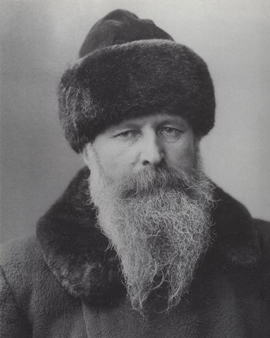Vasily Vasilyevich Vereshchagin, born on October 26, 1842 in Cherepovets, Russia, was more than an ordinary artist of his time. As a war painter, his work was marked by a deep connection to the real suffering and atrocities that wars bring. His paintings bear witness to a dark but at the same time fascinating beauty. He was born into the family of the noble marshal of Cherepovets, and his upbringing was in keeping with his privileged background. At the age of 8 he was sent to a military school and later entered the Saint Petersburg Naval Cadet Corps. Although he performed military service, his artistic talent could not be overlooked. In 1860, he enrolled in the St. Petersburg Academy of Arts, where he continued to develop his painting skills.
Vereshchagin was a nomad, which influenced both his personal and artistic life. After studying at the Petersburg Academy of Art, he traveled through France and the Pyrenees before settling in Paris for a year. There he continued his studies at the prestigious École nationale supérieure des beaux-arts de Paris under the direction of Jean Leon Gerome. However, his works were not limited to Western influence. Vereschagin spent several years in Asia, including Turkestan and India, where he gained deep insights into local culture and history. The landscapes, people and customs of these places strongly influenced his painting.
His time in Asia was marked by wars and conflicts. Vereshchagin was an eyewitness to the Russian conquest of Central Asia and the Russo-Turkish War of 1877/78, and the horrors he saw profoundly influenced his art. His paintings are filled with depictions of battlefields, the wounded and dead, looting and abandoned military hospitals. His work emphasized the darkness and tragedy of war and sought to convey a pacifist message. Vereschagin's travels did not end in Asia, however. He also traveled to the United States, Cuba, the Philippines, and Japan. His fascination with different cultures and societies was evident in his works, which often detailed local customs and traditions.
On April 13, 1904, Vereschagin's life ended tragically. He was aboard the liner Petropavlovsk when it struck a mine and sank. Vereshchagin and Admiral Makarov were among those who perished in the disaster. Vereshchagin left an impressive legacy. His work, consisting of diverse and captivating war paintings, was a vivid document of the conflicts of his time. His paintings, based on sketches he made in battles and on his travels, were impressive both in their detail and emotional depth. His unembellished depictions of war and violence served to convey a pacifist message, reminding us that war is not a glorious adventure but a human tragedy.
×





.jpg)
.jpg)
.jpg)
.jpg)
.jpg)
.jpg)
.jpg)
.jpg)
.jpg)
.jpg)
.jpg)
.jpg)
.jpg)
.jpg)
.jpg)
.jpg)
.jpg)
.jpg)
.jpg)
.jpg)
_-_(MeisterDrucke-1559360).jpg)
_-_(MeisterDrucke-1559360).jpg)
.jpg)
.jpg)
.jpg)
.jpg)
.jpg)
.jpg)
.jpg)
.jpg)
.jpg)
.jpg)
.jpg)
.jpg)
.jpg)
.jpg)
.jpg)
.jpg)
.jpg)
.jpg)
.jpg)
.jpg)
.jpg)
.jpg)






